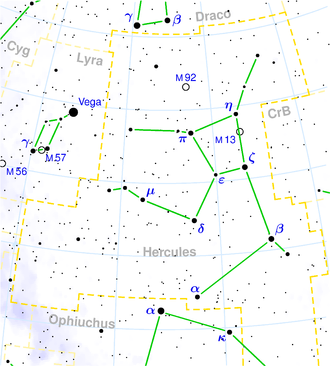NGC 6269
| Galaxie NGC 6269 | |
|---|---|
 | |
| SDSS-Aufnahme | |
| AladinLite | |
| Sternbild | Herkules |
| Position Äquinoktium: J2000.0, Epoche: J2000.0 | |
| Rektaszension | 16h 57m 58,1s[1] |
| Deklination | +27° 51′ 16″[1] |
| Erscheinungsbild | |
| Morphologischer Typ | cD;E2[1] |
| Helligkeit (visuell) | 12,4 mag[2] |
| Helligkeit (B-Band) | 13,4 mag[2] |
| Winkelausdehnung | 2,0′ × 1,6′[2] |
| Positionswinkel | 80°[2] |
| Flächenhelligkeit | 13,7 mag/arcmin²[2] |
| Physikalische Daten | |
| Rotverschiebung | 0,034801 ± 0,000043[1] |
| Radialgeschwindigkeit | (10433 ± 13) km/s[1] |
| Hubbledistanz vrad / H0 | (473 ± 33) · 106 Lj (145,0 ± 10,2) Mpc [1] |
| Geschichte | |
| Entdeckung | Albert Marth |
| Entdeckungsdatum | 28. Juni 1864 |
| Katalogbezeichnungen | |
| NGC 6269 • UGC 10629 • PGC 59332 • CGCG 169-019 • MCG +05-40-012 • GC 5837 • | |
NGC 6269 ist eine 12,4 mag helle Elliptische Galaxie vom Hubble-Typ E2 im Sternbild Herkules und etwa 473 Millionen Lichtjahre von der Milchstraße entfernt.
Sie wurde am 28. Juni 1864 von Albert Marth entdeckt.[3]
Weblinks
- NGC 6269. SIMBAD, abgerufen am 17. Juli 2016 (englisch).
- Auke Slotegraaf: NGC 6269. Deep Sky Observer's Companion, abgerufen am 17. Juli 2016 (englisch).
- NGC 6269. DSO Browser, abgerufen am 17. Juli 2016 (englisch).
Einzelnachweise
Auf dieser Seite verwendete Medien
Autor/Urheber: Sloan Digital Sky Survey, Lizenz: CC BY 4.0
The sky image is obtained by Sloan Digital Sky Survey, DR14 with SciServer.
Angle of view: 4' × 4' (0.3" per pixel), north is up.
Details on the image processing pipeline: https://www.sdss.org/dr14/imaging/jpg-images-on-skyserver/



